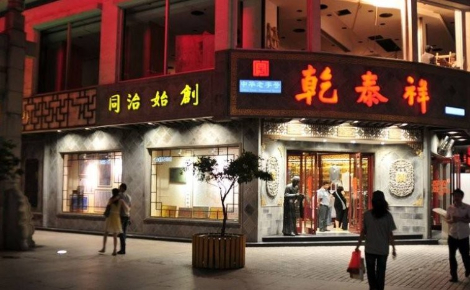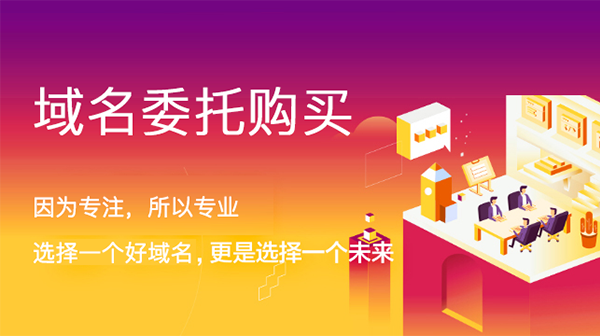乾泰祥品牌怎么样 申请店铺
外推网助力乾泰祥品牌出海!将品牌入驻外推网,定制乾泰祥品牌推广信息,可以显著提高乾泰祥产品曝光,简直是跨境电商爆单神器!目前仅需1000元/年哦~

“吃在松鹤楼,穿在乾泰祥”这句俗谚何时开始流行于苏州城,谁也不曾去认真考证过。但乾泰祥是观前街上最大的绸布商店,也是迄今为止苏州城里最老的绸布店,这是谁也无法否认的事实。它还是全国针纺织品行业“祥”字号理事单位之一,屈指算来创办至今已逾140年。
乾泰祥创始于清朝同治年间(1863年),创始人不详,初为绵绸店。清光绪三十四年(1908)苏州商务总会会员登记名册载:绸缎业,乾泰祥,店址观前街,业主华荣庭,江苏金匮(今属无锡)人。
1929年,苏州大兴市政建设,观前街等街道拓宽,沿线商店因门面缩进纷纷进行翻建改造,乾泰祥乘此第二次翻建之机进行扩张。为了吃进靠宫巷一侧邻店“大亨布店”五开间门面,作为交换条件,出重金盘下对面“桂芳阁菜馆”,易为“大亨布店”店面。由于观前街与宫巷转角处的东阳源南货店要价实在太高未能吃进,因而乾泰祥虽有北临观前,西朝宫巷成犄角之势,但缺了一角,直至1956年公私合营这一角10多平方米的小店才并入乾泰祥。这次翻建乾泰祥共耗资5万银元,造起了三层中西合璧新洋楼,劈对玄妙观正山门,成为观前街上一大亮点。
苏州绸布大店向来有“放账赊销”及“吸收私蓄”两项。所谓“放账赊销”,就是对一些有信誉有家底的老顾客、老熟人,可先取货后会账,一年之中“三节”结账,俗称“端午看一看,中秋算一算,年底还一半。”“放账”由店员个人作担保向熟客放货,一旦发生“飘账”(无法收款),那么该店员得赔账。乾泰祥因为声誉好名气响,因此放账范围比别家广,除苏州城区,还至昆山、常熟及无锡一带,尤其以丝绸之乡吴江一境为多。放账金额也比别家大,如城区闾邱坊巷俞姓一户一年红白两事放账高达5万银元。1937年抗日战争爆发前,乾泰祥每年赊销金额均在20万银元左右,占年销售的一半左右。乾泰祥以高于钱庄的利率吸收私人储蓄,储户多为常来购物而又不愿意抛头露面的富家妇女。当时乾泰祥还故作姿态放风:“收满十万,不再接收。”惹得一些有钱人要托人来存款,其实商店多多益善。巨额存款不仅解决了商店“赊销”所带来的资金周转之困,而且还有助大股东扩张经营,姚氏曾从中取出过16万银元去另外实业开工厂。
1966年“文革”伊始,在“破四旧”中,乾泰祥更名为“苏州第二绸布店”,1967年又改称“解放绸布店”,1975年再次改名为“春光绸布店”,直至1979年才恢复称“乾泰祥绸布商店”。
20世纪80年代中,乾泰祥被列为商业系统首批自主经营的试点单位后,一直是国营绸布行业改革热潮中的领头羊。1985年始先后与江、浙、沪等多家生产厂建立了“厂店挂钩”经销关系,尤其是成为上海章华毛纺厂特约经销点,以至苏州城一度刮起了争购“章华呢绒”旋风。乾泰祥“人无我有,人有我优”的经营原则,被人称作“天天都有新花样”。1991年,率先将个体裁缝引进店堂,店门口最多时设近10个缝纫摊,实行选购面料与量体裁衣一条龙服务,缓解了当时人们“做衣难”的问题。一时苏城大小绸布店纷纷效仿,布店门口设裁缝摊,被喻为苏城特景。1996年乾泰祥经营品种逾3000个,销售额突破2800万元,比80年代增长了6倍,成为苏州绸布业名副其实的龙头。
进入新千年,乾泰祥依靠经营苏州丝绸的优势,开始尝试“走出观前街,走出苏州城”,将自己的品牌丝绸服装打入市区几家有影响的大商场。同时先后在无锡市区、南京新街口和夫子庙等处设立了丝绸特约经销点,取得了良好的效果,也扩大了商店的知名度与信誉度。正是经营上的不断革新,百年老店乾泰祥才经受住了市场经济大潮的洗礼,青春勃发,开拓新的历程。
乾泰祥的发展史,既是一个传承的历史,也是一个创新的历史。1981年、1996年,乾泰祥绸布商店被江苏省人民政府授予先进集体光荣称号;1984年~1999年,被评为苏州市文明单位。
1998年7月,乾泰祥实行改制,为股份合作制企业,国有股占30%。2004年10月实行转制,改名为乾泰祥丝绸有限公司。
在新的领导团队的有力带领下,乾泰祥顺应市场潮流,进行了各方面的改革并取得了优异成果,其生产及销售的丝绸制品质量上乘,款式新颖,引领潮流,深受广大国内外客户的好评,成为丝绸行业中名副其实的龙头。
百年悠久历史的深邃积累,奠定了乾泰祥深厚的文化底蕴,乾泰祥必将秉承百年辉煌,义不容辞地担负起将苏州丝绸文化发扬光大的历史使命。
When did the saying "eat in the pine and crane tower, wear in the qiantaixiang" become popular in Suzhou City? No one has seriously researched it. But no one can deny that Qian taixiang is the largest silk shop in Guanqian Street and the oldest one in Suzhou so far. It is also one of the board members of "Xiang" brand in the national needle textile industry, which has been established for more than 140 years. Qiantaixiang was founded in the Tongzhi period of the Qing Dynasty (1863). Its founder is unknown. It was originally Mian silk shop. In 1908, the membership register of Suzhou chamber of Commerce in the 34th year of Guangxu's reign in the Qing Dynasty contained: silk and satin industry, qiantaixiang, Guanqian Street, owner Hua Rongting, Jiangsu Jinkui (now Wuxi) people. In 1929, Suzhou Daxing municipal construction, Guanqian Street and other streets were widened, and shops along the line were renovated due to the reduction of doors. Qian taixiang took this second opportunity to expand. In order to eat into the five storefront of "tycoon's shop" on one side of the Palace Lane, as a condition of exchange, it is easy to be the "tycoon's shop" on the opposite side of the heavy gold plate. Because the price of Dongyang Yuannan goods store at the corner of Guanqian Street and Gongxiang is too high to eat, although qiantaixiang is facing Guanqian in the north and Gongxiang in the west, it lacks one corner. Until 1956, the 10 square meter shop with public-private partnership was incorporated into qiantaixiang. The reconstruction of qiantaixiang cost a total of 50 thousand silver yuan, built three floors of new Western-style buildings with Chinese and Western styles, and split the gate of Xuanmiao temple, becoming a highlight of Guanqian Street. Suzhou silk and cloth store has always had "credit sale" and "absorption of private savings". The so-called "credit sale" means that for some old customers and acquaintances with good reputation, they can take delivery of the goods first and then meet the accounts. During the year, "three festivals" are settled, which is commonly known as "Dragon Boat Festival, Mid Autumn Festival, and half at the end of the year." "Release" is guaranteed by the clerk to release the goods to the acquaintance. In case of "floating account" (unable to collect money), the clerk has to compensate. Because of its good reputation, qiantaixiang has a wider range of accounts than other countries. Besides Suzhou, it also goes to Kunshan, Changshu and Wuxi, especially Wujiang, the hometown of silk. The amount of money put on account is also larger than that of other families. For example, the amount of money put on account by Yu family in Qiufang lane, Lucheng District is up to 50000 silver dollars a year. Before the outbreak of the Anti Japanese war in 1937, the annual credit sales amount of Qian taixiang was about 200000 silver dollars, accounting for about half of the annual sales. Qian taixiang absorbed private savings at an interest rate higher than that of the bank. Most of the depositors were rich women who came to shop often but were unwilling to show their faces. At that time, Qian taixiang pretended to release the wind: "no more, no more." Some rich people are asked to deposit money. In fact, more shops are better. The huge amount of deposits not only solved the problem of capital turnover caused by the "credit sale" of the store, but also helped the large shareholders to expand their business. Yao took 160000 silver dollars out of it to open another factory. At the beginning of the "Cultural Revolution" in 1966, in the "four old" period, Qian taixiang was renamed as "Suzhou No.2 silk shop", in 1967 it was renamed as "Jiefang silk shop", in 1975 it was renamed as "Chunguang silk shop", and only in 1979 it was renamed as "Qian taixiang silk shop". In the mid-1980s, after being listed as the first pilot unit of independent operation in the commercial system, Qian taixiang was always the leader in the reform upsurge of the state-owned silk and cloth industry. Since 1985, it has established a "factory store linkage" distribution relationship with many manufacturers in Jiangsu, Zhejiang, Shanghai, etc., especially becoming a special distribution point of Shanghai Zhanghua wool textile factory, and even Suzhou once had a "Zhanghua wool" competition. Qiantaixiang's management principle of "no one has it, and everyone has it". It is called "every day there are new patterns". In 1991, we took the lead in introducing individual tailors into the shop. At most, there were nearly 10 sewing stalls at the gate of the shop, which provided a one-stop service of fabric selection and tailored clothing, alleviating the problem that it was difficult for people to make clothes at that time. At that time, silk shops of all sizes in Suzhou followed suit. A tailor's stand was set up at the entrance of the shop, which was known as the special scenery of Suzhou. In 1996, there were more than 3000 varieties operated by qiantaixiang, with sales exceeding 28 million yuan, an increase of six times over that of the 1980s, making it the real leader of Suzhou silk and cloth industry. In the new millennium, relying on the advantages of managing Suzhou silk, Qian taixiang began to try to "walk out of Guanqian Street and Suzhou City" and put his brand silk clothing into several influential shopping malls in the city. At the same time, it has set up silk special distribution centers in Wuxi City, Nanjing Xinjiekou and Fuzimiao, which has achieved good results and also expanded the popularity and credibility of stores. It is the continuous innovation in management that makes qiantaixiang, a hundred year old shop, stand the baptism of the market economy tide, grow young and develop a new course. The development history of qiantaixiang is not only a history of inheritance, but also a history of innovation. In 1981 and 1996, qiantaixiang silk shop was awarded the title of advanced collective by the people's Government of Jiangsu Province; from 1984 to 1999, it was awarded the title of Suzhou civilized unit. In July 1998, qiantaixiang was reformed into a joint-stock cooperative enterprise, with 30% of the state-owned shares. In October 2004, the system was changed to qiantaixiang silk Co., Ltd. Under the strong leadership of the new leading team, Qian taixiang has complied with the market trend, carried out reforms in various aspects and achieved excellent results. The silk products produced and sold by him are of high quality, novel style, leading the trend. They are well received by the customers at home and abroad and become the real leader in the silk industry. The profound accumulation of a century long history has laid a solid foundation for qiantaixiang's profound cultural heritage. Qiantaixiang is bound to uphold the glory of a century and shoulder the historical mission of carrying forward Suzhou silk culture.
本文链接: https://brand.waitui.com/f81b649f2.html 联系电话:请联系客服添加 联系邮箱:请联系客服添加


















 浙公网安备 33011802001999号
浙公网安备 33011802001999号
